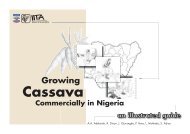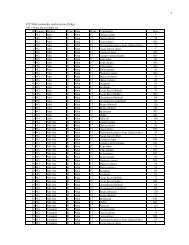Goat and Sheep Fattening Technique in Nigeria - Cassavabiz.org
Goat and Sheep Fattening Technique in Nigeria - Cassavabiz.org
Goat and Sheep Fattening Technique in Nigeria - Cassavabiz.org
You also want an ePaper? Increase the reach of your titles
YUMPU automatically turns print PDFs into web optimized ePapers that Google loves.
COMMERCIAL LIVESTOCK PRODUCTION GUIDE SERIES<br />
<strong>Goat</strong> <strong>and</strong> <strong>Sheep</strong> <strong>Fatten<strong>in</strong>g</strong><br />
<strong>Technique</strong> <strong>in</strong> <strong>Nigeria</strong><br />
United States Agency for<br />
International Development<br />
www.usaid.gov<br />
Information <strong>and</strong> Communication Support<br />
for Agricultural Growth <strong>in</strong> <strong>Nigeria</strong><br />
www.ics-nigeria.<strong>org</strong><br />
ICS-<strong>Nigeria</strong>
Rear<strong>in</strong>g <strong>Sheep</strong> with <strong>Goat</strong> <strong>in</strong> <strong>Nigeria</strong><br />
Choice of L<strong>and</strong><br />
A well-dra<strong>in</strong>ed l<strong>and</strong> with a stock<strong>in</strong>g density of 15 animals per hectare.<br />
Breeds<br />
SHEEP<br />
• West African Dwarf (Local)<br />
• Balami<br />
GOAT<br />
• West African Dwarf (Local)<br />
• Red Sokoto (Maradi)<br />
To start a herd, get male animals of above a year of age with wide deep<br />
chest, well-sprung ribs, <strong>and</strong> strong h<strong>in</strong>dquarters. A buck can serve 20 does.<br />
A doe should have at least two pairs of teats.<br />
Hous<strong>in</strong>g<br />
• Build a house with either bamboo or mud with thatched roof. Space<br />
required is about 2 sq. m. per animal. House should be open on one<br />
side. Walls up to 1.2 m on the other three, with a gap of 0.5 m to 0.8 m<br />
between the walls <strong>and</strong> roof, to provide sufficient ventilation without<br />
drought.<br />
• Hous<strong>in</strong>g could be on raised floor made of bamboo with the thatched roof<br />
cover<strong>in</strong>g mid-way <strong>in</strong>to the pens on both sides. Space could be as above.<br />
• Fenc<strong>in</strong>g: Legum<strong>in</strong>ous fodder trees like Gliricidia sepium <strong>and</strong> Leucaena<br />
leucocephala should be planted around the edges of the paddock to<br />
form a solid fenc<strong>in</strong>g <strong>and</strong> browse plants for the animals. Slatted bamboo<br />
or barbed wires can be used to complete the fenc<strong>in</strong>g.<br />
Management procedure<br />
A quarant<strong>in</strong>e period of 30 days should be observed <strong>in</strong> br<strong>in</strong>g<strong>in</strong>g freshly<br />
purchased animals <strong>in</strong>to a flock. This gives ample time for observation <strong>and</strong><br />
attack by any disease. Animals of about 15 months of age or 12 kg (about<br />
half weight of bag of livestock feed) should be purchased. They should be<br />
bought from the villages rather than the market. The <strong>in</strong>cidence of pestes des<br />
petitis rum<strong>in</strong>ants (PPR) or “Kata” a r<strong>in</strong>derpest-like viral disease is rampant<br />
whenever goats from different sources are gathered <strong>in</strong> the local markets<br />
for sale. Animals are dipped <strong>in</strong> gammatex or supona solution twice <strong>in</strong> two<br />
weekly <strong>in</strong>tervals. From the first day <strong>and</strong> for a period of 4 days, the animals<br />
should be adm<strong>in</strong>istered with triple sulphonamide, like theracazan. On the<br />
2
first day of arrival <strong>in</strong> the farm, they should be immunized with r<strong>in</strong>derpest hyper-immune<br />
serum followed by vacc<strong>in</strong>ation with tissue culture r<strong>in</strong>derpest vacc<strong>in</strong>e<br />
(TCRV) on the 11 th day. On the 3 rd <strong>and</strong> 24 th days of arrival, they should<br />
be treated with broad-spectrum anthelm<strong>in</strong>tic e.g., thiabendazole. In the<br />
absence of veter<strong>in</strong>ary drugs, newly purchased animals should be watched<br />
closely. If there are signs of disease, such animals should be temporarily<br />
culled. If the disease persists the animals should be disposed off.<br />
Feed<strong>in</strong>g<br />
Feed adult animals with hay or crop residue free choice plus legume hay at<br />
1-2 kg/animal/day. Maize, soyabean, cowpea, millet or s<strong>org</strong>hum straws<br />
obta<strong>in</strong>ed after harvest<strong>in</strong>g can be collected, treated <strong>and</strong> given to the animals<br />
free choice. Dissolve about 0.5 of ash made from cocoa pod husk or 1kg<br />
ash from palm bunch <strong>in</strong>to a bucket of water to make a lye solution. Soak as<br />
much of the straw as possible <strong>in</strong>to the solution <strong>and</strong> leave it overnight. Feed<br />
it straight the next morn<strong>in</strong>g or dry for some few hours before feed<strong>in</strong>g, to <strong>in</strong>crease<br />
<strong>in</strong>take. Animals can then be allowed to graze or browse afterwards.<br />
For pregnant does, <strong>and</strong> freshly weaned animals, it may be necessary to<br />
feed some concentrate consist<strong>in</strong>g of 40% wheat offals, 25% brewers’ dried<br />
gra<strong>in</strong>s, 25% palm kernel mean, <strong>and</strong> 10% cassava peels or cowpea husk,<br />
1% vitam<strong>in</strong> <strong>and</strong> 1% salt or supplement with 200g DM of legume fodder per<br />
day <strong>in</strong> the last 2 months of pregnancy <strong>and</strong> up to wean<strong>in</strong>g at 3 months post<br />
partum.<br />
Alley farm<strong>in</strong>g<br />
Legum<strong>in</strong>ous fodder trees (as under fenc<strong>in</strong>g) could be planted <strong>in</strong> rows on<br />
arable l<strong>and</strong>, with food crops planted between the rows. Trees often established<br />
by direct seed<strong>in</strong>g may be sown about 2 weeks after food crops like<br />
maize, cassava, melon, yam etc. Spac<strong>in</strong>g between trees should be about<br />
25 cm (distance from head to the toe on a foot) with four rows of food crops<br />
or 4 strides between two rows of trees. Brows<strong>in</strong>g or cutt<strong>in</strong>g could start 1<br />
year after plant<strong>in</strong>g. Advantages <strong>in</strong>clude provision of high prote<strong>in</strong> fodder for<br />
livestock <strong>and</strong> manure <strong>and</strong> mulch from the fodder ma<strong>in</strong>ta<strong>in</strong> <strong>and</strong> improve soil<br />
fertility for food crops while the trees limit erosion on slop<strong>in</strong>g l<strong>and</strong>.<br />
Diseases<br />
It is better to start a livestock farm dur<strong>in</strong>g the dry season, as many of the diseases<br />
prevalent among small rum<strong>in</strong>ants are commonest dur<strong>in</strong>g the wet season. In<br />
case of outbreak of PPR (Kata), the affected animals should be isolated. Mouth<br />
lesions should be treated with dilute solution of potassium permanganate. The<br />
animals should be dewormed to control diarrhoea <strong>and</strong> treated with a potent antibacterial<br />
agent for 3 days. Always consult your veter<strong>in</strong>arian.<br />
3
About ICS-<strong>Nigeria</strong><br />
Information <strong>and</strong> Communication Support for Agricultural Growth<br />
<strong>in</strong> <strong>Nigeria</strong> (ICS-<strong>Nigeria</strong>) is a project which aims to <strong>in</strong>crease the quantity<br />
<strong>and</strong> quality of <strong>in</strong>formation available for <strong>in</strong>creased agricultural production,<br />
process<strong>in</strong>g, <strong>and</strong> market<strong>in</strong>g <strong>and</strong> also strengthen the capacity of farmer assistance<br />
<strong>org</strong>anizations to package <strong>and</strong> dissem<strong>in</strong>ate <strong>in</strong>formation <strong>and</strong> agricultural<br />
technologies to farmers for the alleviation of rural poverty.<br />
In the recent past, <strong>in</strong>vestment <strong>in</strong> the support services to <strong>Nigeria</strong>n agriculture has<br />
been neglected with the result that this sector has not realized its full potential<br />
to contribute to the prosperity <strong>and</strong> economic development of the country.<br />
Meanwhile, <strong>in</strong>creas<strong>in</strong>g population pressure <strong>and</strong> the accompany<strong>in</strong>g need to<br />
<strong>in</strong>tensify agricultural production is lead<strong>in</strong>g to erosion of the natural resource base<br />
on which agriculture depends.<br />
The susta<strong>in</strong>ability of production is threatened by a vicious cycle of decl<strong>in</strong><strong>in</strong>g soil<br />
fertility <strong>and</strong> <strong>in</strong>creas<strong>in</strong>g problems of pests, diseases, <strong>and</strong> weeds. Moreover, the<br />
lack of knowledge on how to add value through proper storage, process<strong>in</strong>g, <strong>and</strong><br />
market<strong>in</strong>g impedes agricultural growth.<br />
Promis<strong>in</strong>g technologies exist to address these problems, but their adoption is<br />
constra<strong>in</strong>ed by a lack of <strong>in</strong>formation packaged <strong>in</strong> appropriate formats, <strong>and</strong> poor<br />
communication channels for this <strong>in</strong>formation, between farmers <strong>and</strong> the research,<br />
extension, <strong>and</strong> education <strong>org</strong>anizations that are supposed to address these<br />
issues.<br />
ICS-<strong>Nigeria</strong> aims to assist <strong>in</strong> meet<strong>in</strong>g these challenges by develop<strong>in</strong>g<br />
appropriate format materials for dissem<strong>in</strong>at<strong>in</strong>g <strong>in</strong>formation <strong>and</strong> agricultural<br />
technologies to target user groups, while <strong>in</strong>creas<strong>in</strong>g capacity of farmer assistance<br />
<strong>org</strong>anizations to produce <strong>in</strong>formation materials. At the same time, communication<br />
channels will be re<strong>in</strong>forced so that <strong>in</strong>formation flow is enhanced.<br />
Agricultural technologies have been selected on the basis that they will lead<br />
to agricultural commercialization thereby enhanc<strong>in</strong>g rapid <strong>in</strong>come generation<br />
for farmers <strong>and</strong> private sector practitioners. The project is tak<strong>in</strong>g advantage<br />
of exist<strong>in</strong>g agricultural development programs <strong>in</strong> <strong>Nigeria</strong>, national research<br />
<strong>in</strong>stitutes, <strong>and</strong> <strong>in</strong>ternational research <strong>in</strong>stitutes <strong>in</strong> <strong>and</strong> out of <strong>Nigeria</strong> to identify<br />
these technologies. The project is also tak<strong>in</strong>g advantage of exist<strong>in</strong>g successful<br />
partnerships aris<strong>in</strong>g from recent <strong>and</strong> ongo<strong>in</strong>g programs to enhance <strong>in</strong>formation<br />
flow.<br />
ICS-<strong>Nigeria</strong> is funded by USAID.<br />
International Institute<br />
of Tropical Agriculture<br />
www.iita.<strong>org</strong>















